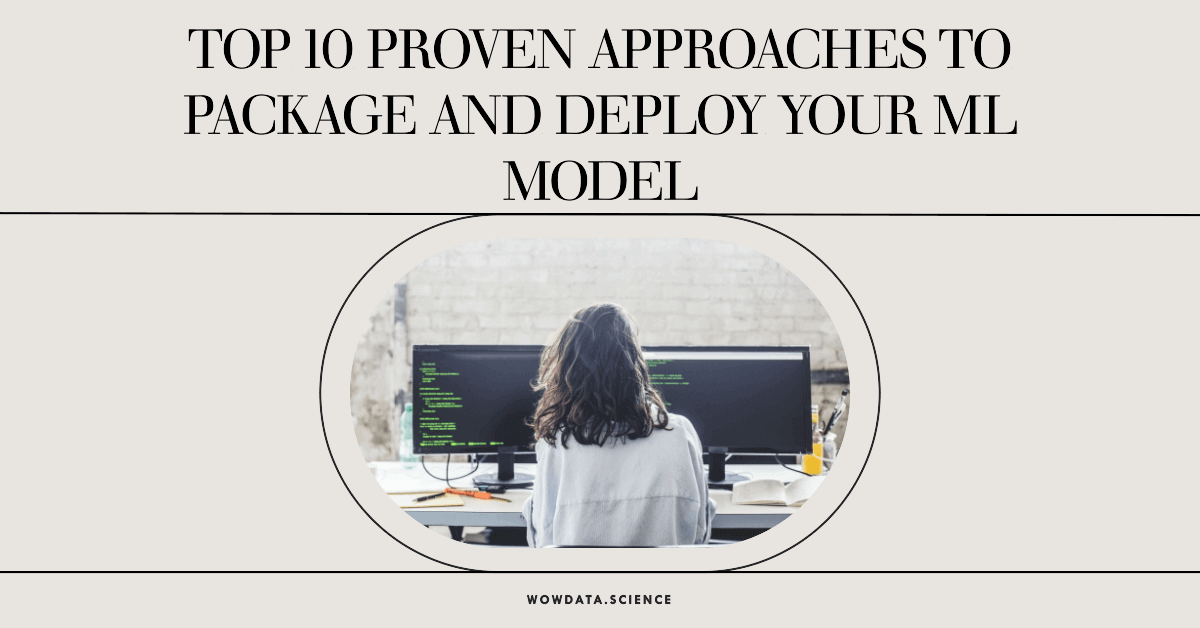Top 10 proven approaches to Package ML Model & Deploy for inferencing
Deploying machine learning models into production requires selecting the right platform based on your needs. Managed cloud services provide end-to-end scaling while open source options offer flexibility. With proper preparation, your model can serve real-time, low-latency predictions at scale.

The moment of truth has arrived. After meticulous efforts fine-tuning models and tweaking parameters, your masterpiece regression model is finally ready to leave the nest and make its mark on the world. But where to begin on its journey to production deployment? Fear not, brave model trainer, for many paths can lead to the promised land of inference if you have the right guide. Cloud platforms stand ready to receive your bundle of code and insights, serving up scalable endpoints to carry forth its predictions. Or perhaps containers are more your speed, encapsulating the model in a virtual vessel equipped for distribution. If you prefer open waters, frameworks like Triton sail under open-source flags but still hit production-level scale. For the coding inclined, pipelines in TensorFlow and PyTorch allow you to customize the deployment dock. There are many vessels that can carry your model safely to the inference harbor - you need only choose the one best suited for your unique model cargo, chart the right course, and let the winds of deployment carry it forth!
Before we begin, we must know that:
- Many options exist for deploying ML models to production
- Managed cloud services provide end-to-end solutions for scale
- Open source tools allow more customization and flexibility
- Packaging the model properly is key across platforms
- The right deployment approach depends on your needs and environment
- With the proper platform, your model can serve real-time predictions at scale
1. Docker container
- Put the model file (linear_model.pkl) and a Python script to load the model and make predictions in a folder
- Create a Dockerfile to copy this folder, install dependencies like scikit-learn, and specify the Python script as the container entrypoint
- Build a Docker image and push it to a registry like Docker Hub
- Run the containerized model to serve predictions, scaling it up as needed
2. Flask web app
- Create a Flask app that loads the model and handles API requests
- Add endpoints like '/predict' that return model predictions as JSON
- Containerize the web app with Docker and deploy to a service like AWS Elastic Beanstalk
3. PyTorch Serve
- Save the model in PyTorch format using pickle/joblib
- Write a model handler script to load and run the model
- Start a PyTorch Serve instance, register the model and deploy it
- Send requests to the model server API to get predictions
- https://pytorch.org/serve/
- https://github.com/pytorch/serve/tree/master/examples/imagenet
4. MLflow model packaging
- Log the model as an MLflow artifact and package it as an MLflow model
- Register and deploy the model to an MLflow model serving tool like Seldon Core
- The model can then be invoked for real-time predictions
- https://www.mlflow.org/docs/latest/models.html
- https://www.mlflow.org/docs/latest/model-deployment.html
5. Amazon SageMaker
SageMaker makes it easy to deploy models to production. You can package the model and a inference script together in a SageMaker-compatible format. Then deploy it to a hosted endpoint on SageMaker where the model will be invoked in real-time.
- https://aws.amazon.com/sagemaker/
- https://docs.aws.amazon.com/sagemaker/latest/dg/how-it-works-hosting-models.html
6. Azure ML Model Deployment
Similar to SageMaker, Azure ML has tools to package and deploy models as web services on Azure. You can deploy to ACI, AKS or FPGA endpoints.
- https://docs.microsoft.com/en-us/azure/machine-learning/how-to-deploy-and-where?tabs=azcli
- https://docs.microsoft.com/en-us/azure/machine-learning/how-to-deploy-model-cli
7. Google Cloud AI Platform
GC AI Platform allows you to create an API that makes your trained model available for prediction. It can auto-scale and monitor the model API.
- https://cloud.google.com/ai-platform/prediction/docs
- https://cloud.google.com/vertex-ai/docs/predictions/deploy-model-api
8. TF Serving
If you save the model in TensorFlow format, TF Serving provides a way to deploy it for production use. It supports gRPC and REST APIs to access the model.
9. Clipper
An open source model deployment framework that simplifies deploying machine learning models for inference. It supports standard frameworks like TensorFlow, PyTorch, and Sklearn.
10. NVIDIA Triton Inference Server
A platform to deploy trained AI models from any framework at scale in production. It provides optimization and accelerates inference.
- https://developer.nvidia.com/nvidia-triton-inference-server
- https://docs.nvidia.com/deeplearning/triton-inference-server/user-guide/docs/index.html
In conclusion, deploying a machine learning model into production for real-time inference requires carefully selecting the right platform and tools based on your needs. For scaling on cloud infrastructure, managed services like AWS SageMaker, Azure ML, and Google Cloud AI Platform provide end-to-end solutions. If open source is preferred, options like Docker, TensorFlow Serving, Clipper and Triton Inference Server give you flexibility and customization. For a web API, Flask provides a simple way to wrap a model in a REST interface. And model packaging libraries like MLflow streamline saving, sharing and deploying models. Whatever path you choose, the destination is a robust, low latency production environment where your regression model can serve predictions at scale. With the right preparation, your model will be ready for its next phase of inference in the wild.
